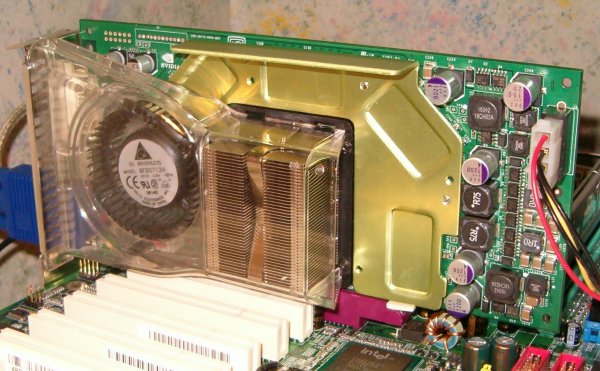FX 5950 Ultra
High end now, with 5950 Ultra, the replacement for 5900 Ultra. From the limited released documentation available to me, 5950 (NV38) is a respun NV35 base, with enhancements (unknown) to allow for a higher clock frequency on the same 130nm process.With no other apparent enhancements over NV35 in terms of performance, it's just a 5900 Ultra at higher clocks. It has the same 4 crossbar, 256-bit wide memory interface, 8 pixel pipeline configuration (with split personality, just like 5900) and the usual round of technologies such as Intellisample HCT, Ultrashadow and CineFX 2.0.
Here's the pertinent information, along with that of its chief competitor.
| GeForce FX 5950 Ultra | Radeon 9800XT | |
| GPU Name | NV38 | R360 |
| Transistor count | Unknown | Unknown |
| Manufacturing process | 130 nanometre | 130 nanometre |
| Pixel pipelines | 8 (**4) | 8 |
| Pixel shader units | 1 per pipe | 1 per pipe |
| Memory bus width | 256-bit/32-byte | 256-bit/32-byte |
| Texturing units | 1 (**2) per pipe | 1 per pipe |
| Core clock | 475MHz | 412MHz |
| Memory clock | 950MHz DDR | 730MHz DDR |
| Pixel fillrate | 3800 Mpixels/sec (**1900Mpixels/sec) | 3296 Mpixels/sec |
| Texture fillrate | 3800 Mtexels/sec | 3296 Mtexels/sec |
| Memory bandwidth | ~30.40GB/sec | ~23.36GB/sec |
Just like with 5900, 5950 has a split personality. Depending on render setup and the application using the GPU, it can have only 4 pixel pipelines working to draw pixels, per clock tick. That can halve theoretical pixel fillrate under certain rendering circumstances. Texel (textured pixel) fillrate is always static, will 8 textured pixels per clock able to be processed at all times. So depending on setup, it can be crippled in pixel processing performance (this means the pixel shader hardware too) compared to its high end peers at ATI.
What's the reference board like?

In as few words as possible, dual slot cooler (hopefully discarded by board partners, despite being fairly quiet), power connector needed, the same dimensions as the old 5900 PCB.
I didn't manage to prise the heatsink and memory heatsink plate off of the reference card in time for publishing, although I'll update as soon as I muster the courage. What I do know is that it almost definitely uses the 950MHz rated, 128MBit K4N26323AE Samsung GDDR2 DRAM's used on 5700 Ultra on the previous page, in GC20 flavour. If it uses different DRAM's when I finally get its green jacket off, I'll eat my, err, invisible and very tasty hat. 8 per side, 2 sides, 4x32M each, for a grand total of 256MB of framebuffer and data memory.
Under ideal conditions, NV38/5950 has 15% more GPU clock and 30% more memory bandwidth than ATI's Radeon 9800XT. Quite the performance advantage, we'll soon see if it makes the most of it.
While I wish that the Intellisample implementation was new, or that it had more colour compression performance, or something new worth talking about versus 5900 Ultra, it doesn't. I'll skip talking about stuff like that, so hit up Tarinder's 22 page FX5900 Ultra extravaganza if you need more details.
The reference board runs the same display output setup as 5700 Ultra, so I won't duplicate my comments. Instead I'll leave you, before we talk about system setup and benchmarks, with a mini screenshot gallery of the new reference board.
Back view
Size comparison to 9800XT reference
Dual slot cooling backplate
System setup now.









